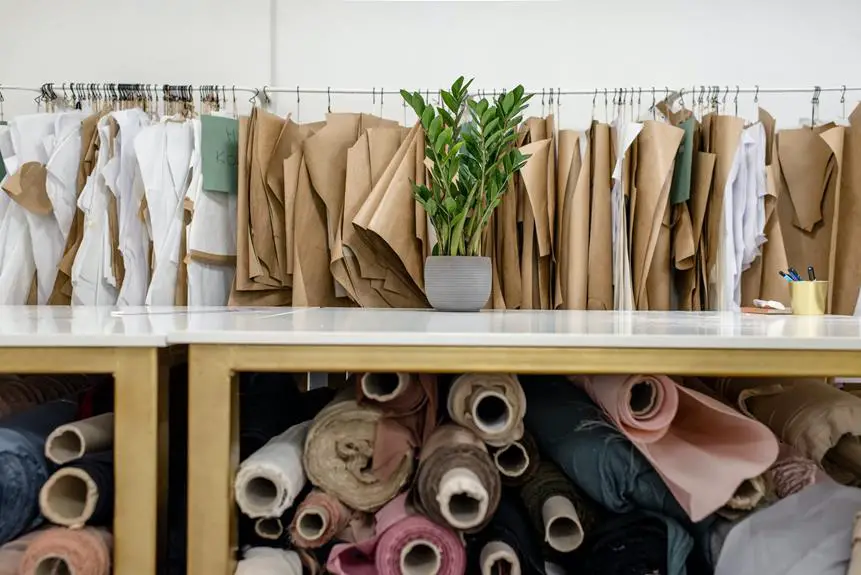When it comes to navigating the world of fabrics, flannel is like finding a cozy, familiar haven in a sea of options. You've probably heard about its warmth and softness, but there's so much more to discover.
In 'Discovering Flannel Fabric: What You Need to Know,' you'll delve into the history, weaves, uses, care tips, and styling of this versatile material. Whether you're a seasoned seamstress or just starting out, mastering the intricacies of flannel fabric will elevate your craft to a whole new level.
So, grab a cup of tea, settle into your favorite reading spot, and get ready to unravel the secrets of flannel.
Key Takeaways
- Flannel fabric originated in the 17th century and was initially made from loosely woven wool fabric.
- Flannel production expanded to include cotton and synthetic fibers.
- Flannel fabric is ideal for winter clothing, bedding, baby clothing, cleaning cloths, and crafts.
- Care tips for flannel fabric include washing in cold water, avoiding bleach, air-drying, and storing away from direct sunlight.
History of Flannel Fabric
When exploring the history of flannel fabric, you'll find its origins date back to the 17th century. The evolution of flannel began with the production of a loosely woven wool fabric, which was then brushed to create a soft, fuzzy surface. This process not only enhanced the fabric's warmth but also gave it a characteristic texture that's now synonymous with flannel. Over time, flannel production expanded to include cotton and synthetic fibers, offering a wider range of colors and patterns.
The cultural significance of flannel can't be overstated. From its humble beginnings as a fabric worn by Welsh farmers to becoming a symbol of grunge fashion in the 1990s, flannel has traversed social and fashion landscapes. It has been embraced by various subcultures and has been incorporated into mainstream fashion, making it a versatile and enduring textile. Its association with comfort and warmth has also made it a staple in casual and outdoor wear.
Understanding the evolution and cultural significance of flannel provides insight into its enduring popularity and its ability to adapt to changing trends while remaining a timeless classic.
Types of Flannel Weaves
To understand the versatility of flannel fabric, you should explore the various types of flannel weaves and their unique characteristics. Flannel weave variations play a significant role in determining the fabric's texture, weight, and durability. Here are some essential flannel weave variations to consider:
- Plain Weave: This is the most basic weave, where the weft (horizontal threads) alternates over and under the warp (vertical threads). It results in a durable and smooth fabric, ideal for everyday wear.
- Twill Weave: With a diagonal ribbed texture, twill weave flannel is known for its strength and wrinkle resistance. It's often used for heavier flannel garments and workwear.
- Flannel Satin Weave: This weave creates a soft and luxurious fabric with a subtle sheen. It's less common in flannel fabrics but adds a touch of elegance to the material.
- Herringbone Weave: This distinctive V-shaped weave adds visual interest to flannel fabric and enhances its durability, making it suitable for both casual and formal wear.
Understanding these flannel weave variations will help you choose the right fabric for your specific needs, whether it's for warmth, comfort, or durability.
Flannel Fabric Uses
With an understanding of the various types of flannel weaves and their unique characteristics, you can now explore the diverse uses of flannel fabric in everyday life.
Flannel fabric is highly versatile and has a wide range of benefits. One of the key advantages is its exceptional warmth, making it ideal for winter clothing such as shirts, jackets, and pajamas. The softness and comfort of flannel also make it a popular choice for bedding, including sheets, pillowcases, and blankets, providing a cozy and relaxing sleep environment. Additionally, flannel fabric is often used for baby clothing and accessories due to its gentle touch on sensitive skin.
In addition to its use in clothing and bedding, flannel fabric has found its way into various other applications. It's commonly used for making cleaning cloths, as its textured surface is effective for dusting and polishing. Flannel can also be utilized for crafts and DIY projects, adding a rustic and homely feel to creations.
While flannel fabric offers numerous benefits, there are alternatives such as fleece and cotton that can be considered based on specific needs and preferences.
Flannel Fabric Care Tips
To care for your flannel fabric properly, follow these easy tips for maintaining its softness and durability.
- Washing Instructions: Always check the care label, but in general, wash flannel fabric in cold water with a gentle detergent to prevent shrinking. Avoid using bleach as it can damage the fibers and cause pilling.
- Drying Tips: To prevent excessive shrinking and maintain the fabric's softness, air-dry your flannel fabric whenever possible. If you choose to use a dryer, select a low heat setting and promptly remove the fabric when it's slightly damp.
- Ironing Techniques: Flannel fabric can wrinkle, so iron it while it's still slightly damp using a warm iron. Be sure to iron on the reverse side to avoid flattening the soft surface.
- Storage Methods: When storing flannel fabric, ensure it's clean and completely dry. Opt for a breathable storage container or fabric bag to prevent moisture build-up and potential mildew. Store in a cool, dry place away from direct sunlight to maintain its color and quality.
Following these care tips will help you keep your flannel fabric in top condition for a long time.
Styling With Flannel
You can style flannel fabric in various ways to create versatile and comfortable outfits for any occasion. Flannel fashion isn't only cozy but also incredibly stylish.
During the colder months, embrace the warmth and comfort of flannel by incorporating it into your wardrobe. For a casual look, pair a flannel shirt with denim jeans and boots. This classic ensemble is perfect for a laid-back weekend or a casual day at the office.
If you're aiming for a more polished appearance, layer a flannel button-up under a sweater or blazer for a smart-casual vibe.
During the winter, flannel-lined pants or jackets provide extra insulation while keeping you fashionable.
In the warmer seasons, opt for lightweight flannel shirts or dresses for a breezy and effortlessly chic look.
When it comes to seasonal styling, consider incorporating fall-inspired colors like deep reds, earthy browns, and forest greens during the autumn months, and lighter pastels and brighter hues for spring and summer.
With flannel, you can easily transition your wardrobe from season to season while staying on-trend and comfortable.
Frequently Asked Questions
Can Flannel Fabric Be Used for Making Baby Clothing and Accessories?
Yes, flannel fabric can be used for making baby clothing and accessories. It's important to ensure fabric safety, so always prewash the fabric to minimize shrinkage and potential chemical residues.
What Are the Best Ways to Store Flannel Fabric to Prevent Damage or Aging?
To keep your flannel fabric in top shape, store it in a cool, dry place away from direct sunlight and moisture. Avoid folding it for long periods, and consider rolling it instead. Regularly inspect for any signs of damage or aging.
Are There Any Specific Health Benefits Associated With Wearing or Using Flannel Fabric?
Wearing or using flannel fabric can provide health benefits such as comfort and warmth. Its soft texture can keep you cozy, making it a great choice for cold weather. It's a practical and comfortable option.
Can Flannel Fabric Be Dyed or Customized at Home?
Yes, you can dye flannel fabric at home using various techniques like tie-dye, dip-dye, or fabric dye. Customization options include block printing, stenciling, or embroidery to add your personal touch to flannel fabric.
What Is the Environmental Impact of Producing Flannel Fabric Compared to Other Textiles?
When it comes to the environmental impact of producing flannel fabric, sustainable production is key. It's crucial to consider the carbon footprint and seek eco-friendly alternatives, ensuring that the process is as environmentally friendly as possible.
- Tetron Fabric for Marine Applications: Durability and Use Cases - June 18, 2025
- Tetron Fabric for Outdoor Furniture: Weather Resistance and Care - June 18, 2025
- Tetron Fabric for Wall Coverings: Style and Application Tips - June 18, 2025






